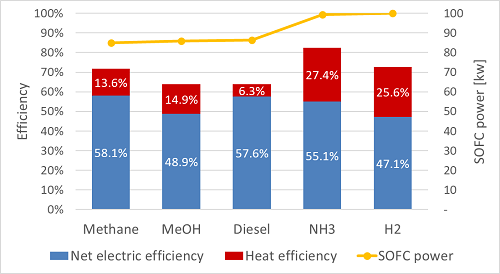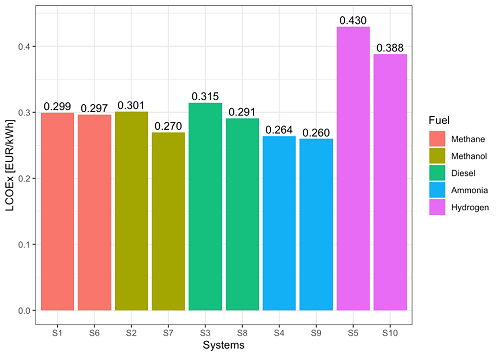This work package is dedicated to a technology impact analysis of the genset developed in the project. The objectives of this WP are the determination of the Genset performance using future renewable fuels for green transport, techno-economic analysis of the genset, emission analysis of the proposed genset and perform its life-cycle analysis.
7.1 WP Leader
7.2 Tasks and Outputs
Future fuels analysis and deployment
- The performance of the genset was evaluated for future fuels that are of interest to the marine sector. The production capacity, the volumetric and gravimetric energy density of onboard storage, technology maturity, safety, fuel cost, storage cost, and environmental impact were the criteria that the future fuels were evaluated against. LNG, methanol, (renewable) diesel, ammonia, and hydrogen were eventually shortlisted.
- The electric power and heat delivered by the SOFC system as well as its efficiency depend on the type of fuel used. A suitable system layout was designed for all five shortlisted fuels and thermodynamically modeled to estimate the electrical and thermal efficiency and the power delivered by the SOFC. The results in Figure 1 show that the use of ammonia results in the highest total efficiency for combined power and heat production.

Figure 1: Results of thermodynamic analysis of SOFC systems for five different fuels
- Deliverable D7.2 - Genset performance report with future fuels – completed
Techno-economic analysis
- The results of the analysis of the genset performance with alternative fuels were subsequently used to evaluate whether these fuels could offer an economically competitive solution. Therefore, a technical economic analysis (TEA) was performed together with a cost-benefit analysis.
- The data from the thermodynamic analysis were combined with cost data of the SOFC system and the different fuels for a techno-economic analysis, considering the capital cost of the different SOFC components, cost of stack replacement, fuel cost and maintenance cost.
- Cathode off-gas recirculation reduces the levelized cost of exergy (LCOEx) for all fuels as well. An additional sensitivity analysis suggested that fuel purchase cost, stack lifetime, and annual interest rate are the three parameters with the highest influence on the system cost.

Figure 2: Results of techno-economic analysis of SOFC systems for five different fuels and without (left) and with (right) cathode off-gas recirculation.
- Deliverable D7.3 - Techno-economic analysis and cost prediction report of genset – completed.
Life cycle analysis (LCA)
- The main objective of this task was to carry out an initial life cycle analysis (LCA) of maritime SOFC power plants for methane and the four alternative fuels selected in the future fuel analysis, namely methanol, diesel, ammonia, and hydrogen.
- The impacts from fuel production were combined with the energy content and the SOFC system efficiencies to quantify the life cycle performance of each fuel and compare it to benchmark systems based on diesel and internal combustion engines.
- A 99% reduction in acidification, eutrophication (marine and terrestrial) and photochemical ozone formation is possible for almost all SOFC fuels compared to ICE diesel (NOX tier II) and ICE HFO.

Figure 3: Comparison of fuel GWP per MJ energy content (LHV) including production and use (source: ecoinvent 3.9.1, Hydrogen Tools, Mehmeti et. al (2018) and Morgan (2013).
- Deliverable D7.1 - Screening LCA report of the genset – completed.
- Deliverable D7.4 - Full LCA report on the hybrid genset and integration with cruise ships – completed.
Emission analysis
- A detailed emission analysis is performed in this task to quantify the emissions from the genset compared to the emissions from current state-of-the-art marine ICEs. A literature review of ship emissions of relevance for adverse health impact focused on emission factors of air pollutants regulated in emission and air quality legislation.
- The review defined a base case using air pollutants between the traditional use of heavy fuel oil (HFO) in internal combustion engines (ICE), a case using liquified natural gas (LNG) in ICEs, and the SOFC genset run on LNG.
- Emission measurements will be conducted over three test weeks at DLR. These tests are optimally scheduled for the first three weeks of October and the testing phases include 1-2 weeks of static and dynamic tests, followed by 1-2 weeks of real profile tests.

Figure 4: Weatherproof box for exhaust extraction
- Emission measurements at the demonstrator will utilize a range of instruments, including a Scanning Mobility Particle Sizer or Condensation Particle Counter for particle size distribution and number concentration, an Optical Particle Counter for PM5 mass concentration, and an Aethalometer for black carbon concentration. Gas components will be analyzed using Fourier Transform Infrared Spectroscopy (FTIR), alongside dedicated NOX and SO2 analyzers.

Figure 5: Emission measurements at the Demonstrator
- Deliverable D7.5 - Emission analysis report of the genset – ongoing.
Health Impact Assessment (HIA)
- The NAUTILUS project studies the toxicological effects of shipping emissions on human health. Dose-dependent toxicological studies on human tissue exposed to these emissions are necessary for accurate health impact assessments and comprehensive risk evaluations. Within the project, such studies on human tissue reactions to emission exposure were conducted in two areas exposed to air pollution from maritime transport (Hamburg and Trelleborg), with the potential extension to other locations for inclusion in health impact assessments (HIA) being considered.

Figure 6: Toxicological effects of shipping emissions
7.3 Duration and Status
- Months 1 - 54
- Status – work in progress
7.4 WP7 Highlights
- The performance of the genset was evaluated for future fuels that are of interest for the marine sector. A suitable system layout was designed for all five shortlisted fuels and thermodynamically modeled to estimate the electrical and thermal efficiency and the power delivered by the SOFC (D7.2).
- The techno-economic analysis of maritime SOFC power plants for methane and four alternative fuels, namely methanol, diesel, ammonia, and hydrogen was completed. From the analysis, it was concluded that SOFCs using either methanol or diesel are close to the economic parity compared to a diesel-ICE baseline (D7.3).
- A screening life cycle analysis (LCA) was completed for SOFCs. Methane and four alternative fuels, namely methanol, diesel, ammonia, and hydrogen, were assessed using the performance of the genset as reported in D7.2, focusing on global warming potential during the operational phase of the genset.
- A full LCA of the hybrid genset and integration with cruise ships was completed, comparing the environmental performance of the SOFC genset with various fuels to benchmark systems based on internal combustion engines with HFO, diesel (Tier II and III) and LNG (D7.4).
- The emission analysis task started out with a literature review of ship emissions of relevance for adverse health impact (SO2, NOX, PM, BC, ...). This data was used for a preliminary Health Impact Assessment (HIA) of population mortality for the south Sweden region and Hamburg area. A measurement set-up including an FTIR instrument and state-of-the-art PM characterization techniques for SOFC emission measurements has been designed and tested for SOFC-like exhaust conditions at SolydEra SPA (SE_SPA).
- The analysis of the experimental emission tests at SolydEra SPA (SE_SPA) was finalized, as well as the design interface between the demonstrator and emission measurement set-up.
7.5 Next steps
- A final HIA will be performed at M50 based on the real experimental validation of air pollutant emission factors at the NAUTILUS SOFC demonstrator by Lund University (ULUND)
- Analysis of the emission measurements carried at the demonstrator by Lund University (ULUND).
Last updated: October 23th, 2024
